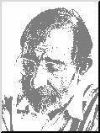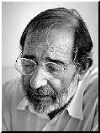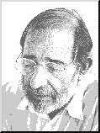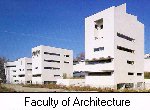![]()



"Tradition is a challenge to innovation"
Due to the untimely demise of our newly updated server, our "Recent News" section is anything but recent. Please bear with us while we re-catalogue our information. This did/does/will include news on Siza's breath-taking contribution to EXPO '98 (the Portuguese Pavilion), new developments in the Chiado area of Lisbon, and recent international awards in recognition of Portugal's most celebrated architect.
In the meantime, if you're yesteryear inclined...
![]() 26th
May 1996
26th
May 1996
The exhibition "Álvaro Siza - Buildings and Projects" opened today in Matosinhos, the architect's birthplace. The President of the Portuguese Republic, Jorge Sampaio, attended the inauguration ceremony. Models of many of Siza's projects built since 1980, various pieces of furniture, photographs of Siza and over a thousand drawings and sketches will be on display in Matosinhos until July 28th 1996.
The exhibition, which will later move to Tenerife, Sardinia, Brussels, Brazil and the United States, is expected to be visited by over 150,000 people.
![]() 13th
May 1996
13th
May 1996
Álvaro Siza was today awarded the honorary title of Fellow of American Institute of Architects. The awards ceremony, which Mr. Siza was unfortunately unable to attend, took place in Minneapolis, USA.
![]() 24th
January 1996
24th
January 1996
One of Siza's most important on-going projects - restoration of the Chiado area of Lisbon, a historic commercial sector that was all but completely destroyed by fire in August 1988 - is currently being complicated by the construction of a new section of underground between Lisbon's Praça de Rossio and the Cais do Sodré train terminal. Excavation work has weakened the foundations of several buildings in the area, the ancient ruins of Carmo Convent the worst affected. Siza Vieira has contacted the heads of the Metropolitan to find out "what steps are being taken to safeguard the monument".
In an interview given to a local newspaper, Siza states: "The building was in a poor state of repair even before work on the Metro was started. We'd already pointed out the existence of cracks running through the structure". He went on to back the decision taken by the Association of Portuguese Archaeologists - which runs the museum housed in the Convent - to move its exhibits to a safe place. "We can't just sit around and wait. The problem needs to be urgently addressed".
(click here for the unabridged article)
Álvaro Siza Vieira is the greatest living Portuguese architect - perhaps the finest the country has ever produced - whose works over the years have proven to be amongst the most coherent and complete of all architectural works this century. This coherence is not based on stylistic repetition: it lies in the progressive evolution of the act of designing and, as such, Siza’s work is immediately recognisable wherever it be found.
The architect has frequently been linked to Minimalism, as if he were in fact a Minimalist architect. If the subliminal structure of his work is in keeping with a particular movement, however, then I believe that movement to be Expressionism: expressionist roots are revealed at a deeper level in the formal structures of all his works: more immediately patent in the forms of the Boa Nova Tea House, more elaborate and subterranean in the Setubal College or the Santiago Museum, expressionist reflection is perhaps a common thread that runs throughout his work.
The quality of light and the way in which it is manipulated is another. The markedly plastic tactile light - not passive light, in the sense that it provides a service (the light that illuminates the "simple volumes" of a Le Corbusier) but light dealt with as an expressive object - remains, perhaps, the very stuff of architecture. And in Siza it is conceived as being rooted in expressionism. Perhaps the Chiado experience, the contact with windows and the thickness of the walls, will result in a certain hardening of light - not a loss of quality, but rather an alteration to this quality.
 Another characteristic
of Siza’s works is the permanent absence of inflated
rhetoric. One of the reasons for this - there are others - is the
scale he always introduces, regardless of the size of the
project. It is interesting to note how there has always been an
attempt to incorporate a German influence into Portuguese
architecture. It seems to me that the Austrian influence is far
greater than the German, and that control of scale is one of the
aspects of this influence. In Siza’s case the influence is a
recollection that has been absorbed in refined style, but it is
present nonetheless. This precision of scale is contributed to by
the subtle understanding of the surroundings, and the recent
project for the Faculty of Architecture
in Oporto, in which he rejects a large-scale solution, is a fine
example of this.
Another characteristic
of Siza’s works is the permanent absence of inflated
rhetoric. One of the reasons for this - there are others - is the
scale he always introduces, regardless of the size of the
project. It is interesting to note how there has always been an
attempt to incorporate a German influence into Portuguese
architecture. It seems to me that the Austrian influence is far
greater than the German, and that control of scale is one of the
aspects of this influence. In Siza’s case the influence is a
recollection that has been absorbed in refined style, but it is
present nonetheless. This precision of scale is contributed to by
the subtle understanding of the surroundings, and the recent
project for the Faculty of Architecture
in Oporto, in which he rejects a large-scale solution, is a fine
example of this.
Siza himself says: "What I appreciate and look for most in architecture is clarity and simplism. Simplicity and simplism are known to be opposites, just as unity and diversity are not. Simplicity results from the control of complexity and the contradictions of any programme [...] Complexity and internal contradictions - external, also, when a new structure is confronted with what preceeded and what surrounds it, taking on a not necessarily predictable destiny. For this reason, the more character a building has and the clearer its form, the more flexible its vocation."
Pedro Vieira de Almeida, July 1995.
Álvaro Joaquim Melo Siza Vieira was born in Matosinhos (Portuguese only) near Oporto, Portugal, in 1933. From 1949-55 he studied at the Escola de Belas Artes in Oporto, his first design built in 1954. From 1955-58 Siza worked with the architect Fernando Tavora. He taught at the School of Architecture (ESBAP) from 1966-69 and was appointed Assistant Professor of Construction in 1976.
He has been a Visiting Professor at the Ecole Polythechnique of Lausanne, the University of Pennsylvania, the Los Andes School in Bogota and at the Graduate School of Design of Harvard University as Kenzo Tange Visiting Professor. He continues to teach at the Oporto School of Architecture.
 Among many current
designs, 1200 homes are now being built in Malagueira, Evora,
with the designs for the Setubal College
of Education, the Oporto Faculty of
Architecture and Aveiro University Library nearing
completion. Further on-going designs include the Galicia Museum
of Contemporary Art in Santiago de Compostela, Spain, the Oporto
Modern Art Museum and, recently, a major mixed-use development in
Boavista, Oporto. He has been co-ordinating the Schilderswijk
Zone 5 Renovation Plan in The Hague, Holland, since 1985, and is
drawing up a scheme for blocks 6-7-8 in Ceramique Terrein,
Maastricht. He is also supervising reconstruction of the
fire-damaged area of Chiado in Lisbon. Other major works include
the Praca de Espanha/Avenida Malhoa Master Plan in Lisbon and the
design for the Meteorological Centre of the Olympic Village in
Barcelona.
Among many current
designs, 1200 homes are now being built in Malagueira, Evora,
with the designs for the Setubal College
of Education, the Oporto Faculty of
Architecture and Aveiro University Library nearing
completion. Further on-going designs include the Galicia Museum
of Contemporary Art in Santiago de Compostela, Spain, the Oporto
Modern Art Museum and, recently, a major mixed-use development in
Boavista, Oporto. He has been co-ordinating the Schilderswijk
Zone 5 Renovation Plan in The Hague, Holland, since 1985, and is
drawing up a scheme for blocks 6-7-8 in Ceramique Terrein,
Maastricht. He is also supervising reconstruction of the
fire-damaged area of Chiado in Lisbon. Other major works include
the Praca de Espanha/Avenida Malhoa Master Plan in Lisbon and the
design for the Meteorological Centre of the Olympic Village in
Barcelona.
Álvaro Siza's works have been exhibited in Copenhagen (1975), Aarhus and Barcelona (1976), the Biennale of Venice (1978), Milan (1979), the Museum of Architecture in Helsinki and the Alvar Aalto Museum, Finland (1982), the Georges Pompidou Centre, Paris (1982), the Institute of Contemporary Arts, London, and the Stichting Wonen, Amsterdam (1983), Technische Hogenschool, Delft, ESBAP and Almada Negreiros Gallery, Lisbon (1984), International Building Exhibition, Berlin (1984 and 1987), Biennale of Paris and Massachusetts Institute of Technology, Cambridge (1985), 9H Gallery, London (1986), Columbia University, New York (1987), Harvard Graduate School of Design, Cambridge (1988), Georges Pompidou Centre, Paris, and MOPU Gallery/Ministério de Obras Publicas, Madrid (1990), RIBA, London (1991), Colegio de Arquitectos, Seville (1991), deSingel Gallery, Antwerp (1992), Rui Alberto Gallery, Oporto, the MOPU, Madrid, the DESSA gallery, Ljubljana/Slovenia (1993), Colegio de Arquitectos, Granada and Seville, Sala de Risco, Lisbon (1994).
He has also participated in various seminars and conferences in Portugal, Spain, Italy, Germany, France, Norway, Holland, Switzerland, Austria, England, Colombia, Argentina, Brazil, Japan, Canada and the United States.
Having been invited to participate in international competitions, Siza obtained first place in Schlesisches Tor, Kreuzberh, Berlin (now completed), the restoration of Campo di Marte in Venice (1985), and the re-development of the Casino and Café Winkler, Salzburg (1986). He took part in the competitions for Expo 92 in Seville, Spain (1986), for Un Progretto per Siena, Italy (1988), for the La Defensa Cultural Centre in Madrid, Spain (1988/89), which he won, for the Bibliotheque de France in Paris (1989/90) and for the Helsinki Museum (1993).
The Portuguese Department of the International Association of Art Critics awarded him the Prize for Architecture in 1982. He received an Award from the Portuguese Architects Association in 1987.
In 1988 he was awarded the Gold Medal for Architecture by the Colegio de Architectos, Spain, the Alvar Aalto Foundation Gold Medal, the Prince of Wales Prize in Urban Design from Harvard University, and the European Architectural Award by the EEC/Mies van der Rohe Foundation, Barcelona. In 1992 he was awarded the Pritzker Prize by the Hyatt Foundation of Chicago for his lifelong achievements. In 1993 he was awarded the National Architecture Prize by the Portuguese Architects Association. Doctor Honoris Causa by the University of Valencia (1992) and by the Ecole Polythechnique Federal of Lausanne (1993).